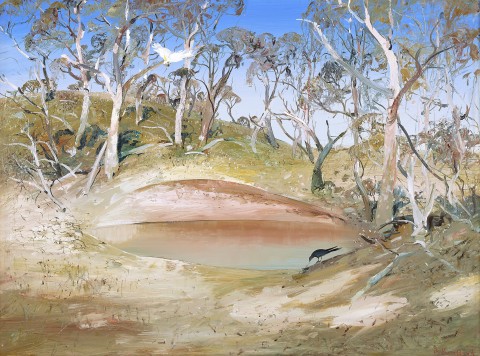WATERHOLE NEAR CANBERRA, c.1971
ARTHUR BOYD
oil on composition board
44.5 x 60.0 cm
signed lower right: Arthur Boyd
Private collection
Sotheby’s, Sydney, 17 November 1988, lot 376
Private collection, Melbourne
‘Throughout the course of his career, Arthur Boyd has been an untiring and extremely skillful and beautiful painter of landscapes… The effects of great distance and extreme clarity of light are nostalgic, and the most everyday objects and happenings become literally transfigured.’1
From his earliest impressionist vignettes of the Mornington Peninsula outside Melbourne, to his shimmering golden depictions of the Wimmera wheat district and masterful works immortalising his beloved Shoalhaven River (see lot 44), Arthur Boyd is without doubt one of the country’s most revered landscape painters. Fascinated by the vagaries of nature - from the primordial tangle of the Australian bush to the various ways humanity has intervened with farming and mining – indeed, his highly personalised, expressive visions of his homeland are deeply embedded within our national consciousness.
After twenty-one years living abroad in England, in late 1971 Boyd and his wife returned to Australia to take up a five-month residency at the Australian National University, Canberra. Reacquainting himself, Boyd was immediately struck by the beauty of the bush terrain surrounding the capital which, untamed and rugged, was far removed from the romantic English countryside to which he had grown accustomed. As he recalled, from his apartment in the inner suburb of Garran he ‘could literally walk into the country in five minutes. It was quite marvelous: there was this undulating, rolling quality. And the weather – the blueness of the sky… the blue is so intense compared to the Victorian [light].’2 It was also during this period that Boyd was introduced to the unspoilt magic of the Shoalhaven River region, having been invited by the Sydney art dealer, Frank McDonald, to spend the weekend at his Bundanon property on the south coast of New South Wales. Describing his first experience of the area, Boyd reminisced ‘I can remember the day vividly. It was so hot and searing, the oil ran from the palette onto the sand. I never paint in the shade or wear a hat because it distorts the light on whatever I’m painting. I can remember the heat was terrifying.’3
With its crystalline blue sky, parched blonde ground, straggly gum trees and signature cockatoo wheeling around the waterhole, Waterhole near Canberra, c.1971 tangibly conveys the somnolent mood and dry white heat of one such blazing summer’s day. In his treatment of this harsh, inland landscape, there are also unmistakable affinities with the lyrical depictions of artistic predecessors such as celebrated Heidelberg painter Tom Roberts, as well as echoes of Boyd’s own earlier oeuvre – most particularly, the groundbreaking Wimmera series. Exuding a sense of colour, light and atmosphere that is unmistakably Australian, indeed the work encapsulates well what author Sandra McGrath extols as Boyd’s ‘…prodigious ability to take the nature of the subject and render it in a manner which captures the essence of its particular properties at that time, to imbue it with a sense of character and meaning which is the result of his own immediate emotional or psychological response.’4
1. O’Shaughnessy, B., ‘Introduction’, Arthur Boyd: Retrospective exhibition, Whitechapel Gallery, London, 1962, pp. 16 – 17
2. Hart, D., Arthur Boyd: Agony and Ecstasy, National Gallery of Australia, Canberra, 2015, p. 115
3. Hoff, U., The Art of Arthur Boyd, Andre Deutsch, London, 1986, p. 486
4. McGrath, S., The Artist and The River: Arthur Boyd and The Shoalhaven, Bay Books, Sydney, 1982, p. 63
VERONICA ANGELATOS
